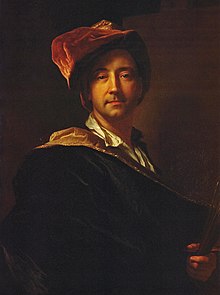Hyacinthe Rigaud
| Hyacinthe Rigaud | |
|---|---|

Self-portrait in a turban, 1698, Perpignan, Musée Hyacinthe Rigaud.
|
|
| Born |
Jacint Rigau-Ros i Serra 18 July 1659 Perpignan |
| Died | 29 December 1743 (aged 84) Paris |
| Nationality | French |
| Education |
Charles Le Brun Paul Pezet (presumed) Antoine Ranc (presumed) |
| Known for | painting, portraiture |
| Notable work | coronation portrait of Louis XIV; The Presentation in the temple; portrait of Bossuet in winter costume; portraits of Louis XIV |
| Movement | Baroque |
| Awards | Prix de Rome 1682 |
Hyacinthe Rigaud (French pronunciation: [ʁigo]; 18 July 1659 – 29 December 1743) was a French baroque painter of Catalan origin whose career was based in Paris.
Hyacinthe Rigaud was born in Perpignan (Pyrénées-Orientales), the grandson of painter-gilders from Roussillon and the elder brother of another painter (Gaspard). He was trained in tailoring in his father's workshop but perfected his skills as a painter under Antoine Ranc at Montpellier from 1671 onwards, before moving to Lyon four years later. It was in these cities that he became familiar with Flemish, Dutch and Italian painting, particularly that of Rubens, Van Dyck, Rembrandt and Titian, whose works he later collected. Arriving in Paris in 1681, he won the prix de Rome in 1682, but on the advice of Charles Le Brun did not make the trip to Rome to which this entitled him. Received into the Académie royale de peinture et de sculpture in 1700, he rose to the top of this institution before retiring from it in 1735.
Since Rigaud's paintings captured very exact likenesses along with the subject's costumes and background details, his paintings are considered precise records of contemporary fashions.
Rigaud was born with the Catalan name Jyacintho Rigau or Jacint Rigau i Ros This is variously translated as Híacint Francesc Honrat Mathias Pere Martyr Andreu Joan Rigau – in Perpignan, which became part of France by the Treaty of the Pyrenees (7 November 1659) shortly after his birth.
...
Wikipedia
